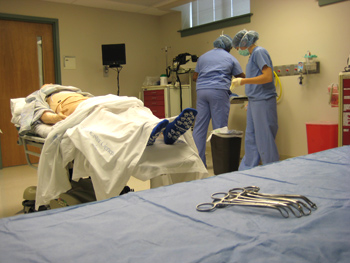 When the students at Lancaster General College of Nursing and Health Science were children, many of their living rooms were likely transformed into doctor’s offices. These future medical students would check the pulse and take the temperature of their dolls and action figures to determine the plastic prognosis. In their innocence, these would-be healers couldn’t have realized that one day, playing doctor to Betsy Wetsy and GI-Joe would become a major part of their medical training. Going from imagination to reality can be surreal but, like many serious game environments, saving fake bodies may help save the real ones. In short, playtime is over.
When the students at Lancaster General College of Nursing and Health Science were children, many of their living rooms were likely transformed into doctor’s offices. These future medical students would check the pulse and take the temperature of their dolls and action figures to determine the plastic prognosis. In their innocence, these would-be healers couldn’t have realized that one day, playing doctor to Betsy Wetsy and GI-Joe would become a major part of their medical training. Going from imagination to reality can be surreal but, like many serious game environments, saving fake bodies may help save the real ones. In short, playtime is over.
This week, tech transfer professionals from the Innovation Transfer Network visit Lancaster General Hospital, where doctors in the Clinical Simulation Lab are using robotic mannequins to train medical students. These dolls breath, talk, seize, show a pulse and even run a fever to train young doctors in everything from IV placement to open heart surgery. According to Simulation Learning director Joe Corvino, the sims are as real as it gets.
“They breathe, they blink, they talk, we can have them cry, chest rise, heart sounds, lung sounds, bowel sounds,” says Corvino. “Through this technology, we can put our students into realistic situations where they are presented with a patient, they have to do a basic assessment and from that assessment, they have to determine a plan of care, communicate that plan to other team members, and then they need to treat that patient through anything from oral medication to IV medication, knowing that the patient could seize, shock or pace and may even require CPR.”
A burgeoning technology growth sector in Pennsylvania, serious games and simulations have become increasingly prevalent in life-and-death industries like medicine and the military. Chronicling their growth is the Innovation Transfer Network, whose Simulation and Serious Games Xchange group meets quarterly to review potential projects in the simulation industry. The visit to Lancaster General on Sept. 8 will be a fact-finding mission where the group will review the success of the robot mannequin patients and consider possible commercialization options and potential partnerships. Corvino and his team welcome ITN and look forward to discussing the future of medical simulations in PA.
“We are really looking to see if there is some interest out there in developing a partnership, to maybe go into business looking from a safety perspective, using simulation for safety standards that need to be met within an organization,” says Corvino. “We’re also using simulation here for team building exercises and crisis resource management. Knowing who is in your team, what your responsibility is and then being able to competently carry out that role in a crisis situation. These are focuses I could see being developed through a meeting such as this.”
Source: Joe Corvino, Lancaster General College of Nursing and Health Science
Writer: John Steele